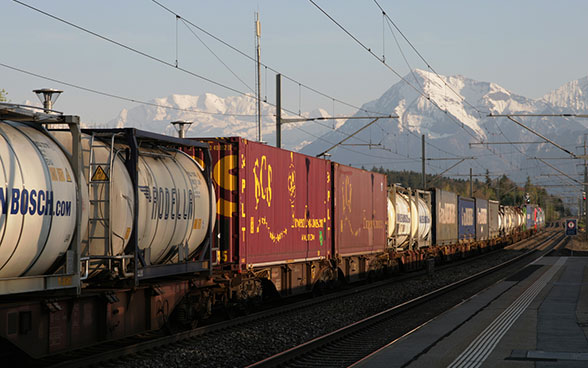30 years of the Alpine Initiative – 30 years of relocation policy 15/02/24
< ZurückSource: https://www.bav.admin.ch/bav/de/home/publikationen/bav-news-blog/30-jahre-alpeninitiative.html
Author: -
30 years of the Alpine Initiative – 30 years of relocation policy
February 15, 2024 - With their yes to the Alpine Initiative, voters in 1994 commissioned the federal government to shift transalpine freight transport from road to rail. The relocation policy has been implemented by the BAV for 30 years. The target of 650,000 truck trips per year has not yet been achieved, but the railway's market share in freight transport has increased to almost 75 percent. Without the measures taken, 800,000 additional trucks would drive through the Alps every year.

Thanks to the Alpine Initiative, a large proportion of transalpine freight traffic is transported by rail.
© BAV
By a narrow margin, on February 20, 1994, the voters, contrary to the recommendations of the Federal Council and Parliament, enshrined the Alpine protection article in the Federal Constitution and thereby gave the mandate to shift transit freight traffic through the Alps from the road to the rail. In the Freight Transport Shift Act, the Federal Parliament stated that the number of trips by domestic and foreign trucks and semi-trailers should be reduced from 1.4 million in 2000 to 650,000 per year.
This goal has not yet been achieved; in 2022 there were 927,000 heavy freight vehicles. However, compared to the reference year 2000, there was a decline of 33.9 percent despite overall growing traffic. And without the relocation measures, an additional 800,000 trucks would be driving through the Alps on the road today. Compared to its neighboring countries France and Austria, Switzerland currently has a very high rail share of around 72.5 percent of transalpine freight traffic. In 2022 it was 9.6 percent in France and 26.6 percent in Austria.
The adoption of the Alpine Initiative marked the starting point for a new direction in transport policy. The railway took on the dominant role in the transport of goods through the Alps; Transport policy became an essential part of environmental policy.
Wide range of measures and instruments
The successes of the relocation policy were made possible thanks to numerous measures and instruments that the federal government has decided and implemented over the past 30 years. This includes, for example, the performance-related heavy vehicle tax (LSVA), which is based on the kilometers driven in Switzerland, the permissible total weight of the truck and the vehicle's emissions. Two thirds of the income from the LSVA flow into the railway infrastructure fund for the construction of railway projects.
To promote modal shift, Switzerland built the NRLA and the 4-meter corridor on the Gotthard axis for 24 billion francs. Thanks to the base tunnels through Gotthard, Ceneri and Lötschberg and the uniform profile, freight trains can run in larger numbers and under easier conditions. Travel times between north and south have become shorter. The relocation of goods is supported and reinforced by operating compensation and investment aid for unaccompanied combined transport, the rolling highway and reloading terminals. Within this framework, the federal government now also wants to implement measures to make the relocation even more attractive for shorter transalpine transport.
The acceptance of the Alpine Initiative initially strained relations with the EU, but ultimately the new policy was able to gain broad international support with the land transport agreement. In the land transport agreement, the EU recognized the Swiss goals and instruments, in particular the LSVA and the night and Sunday driving ban for trucks.
Access routes abroad and reliability of traffic as challenges
The potential of modal shift has not yet been exhausted. Various factors such as the delay of many trains, the numerous and often poorly coordinated construction sites on the railway network, but also the slow expansion of the northern NEAT access routes are currently inhibiting the relocation. The current challenge is to ensure the reliability and quality of freight transport on the access routes. Domestically, the aim is to further develop the LSVA and adapt it to the increasing decarbonization of road freight transport.
Shifting happens every day. For each transport, a new decision is made as to whether it will be transported by road or rail. The framework conditions of the relocation policy must therefore be adapted to a dynamic market and a constantly changing environment. The incentives for relocation must always be set anew: a decrease in competition on the rails or a reduction in subsidies without simultaneous realization of productivity progress can result in the loss of rail transport to the road.





